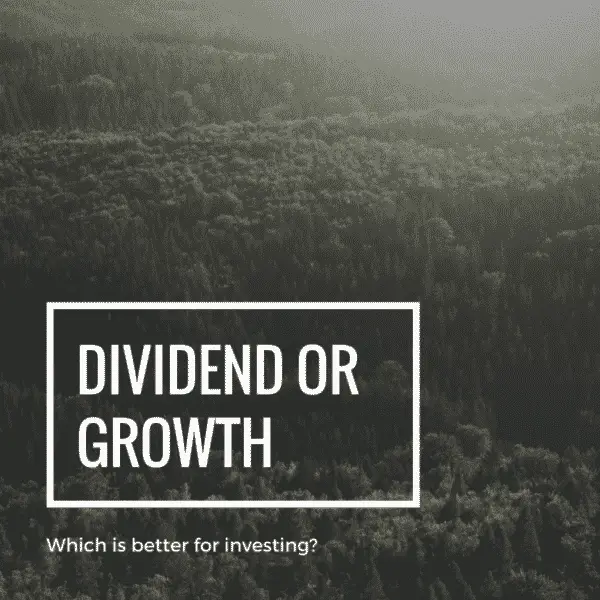Investing in dividend stocks or growth stocks can be a challenge for investors. Many people are conflicted as to what types of stocks they should be investing in. With FAANG stocks, flying with 100+% gains. Many investors get FOMO (fear of missing out) on the talk of the hot stocks. So, dividend or growth? What should you be investing in? We have build a dividend portfolio of high-quality, reasonably valued dividend growth stocks that provide residual income into perpetuity. We think this is a great strategy for investing over the long-term.
Dividend or Growth: Which is Better?
The classic debate about dividends or growth. Do you know what is better? Both! What if I told you can get growth and dividends in one? Try dividend growth investing.
What is a Dividend Stock?
A dividend is defined as a payment made by a corporation to its shareholders. Usually these payouts are made in cash (called “cash dividends”), but sometimes companies will also distribute stock dividends, whereby additional stock shares are distributed to shareholders.
Stock dividends are also known as stock splits. In this case, dividend stocks are stocks you will buy in hopes to be paid dividends, so your profit increases. Check out our 7 Great Dividend Growth Stocks for a Secure Retirement.
What is a Growth Stock?
A growth stock is a share in a company whose earnings are expected to grow at an above-average rate relative to the market. Growth stocks don’t typically pay dividends, because the companies would much prefer to reinvest the earnings in their own company. These stocks are a little more risky.
A growth stock is form of investing in long-term capital appreciation. A growth stock can be highly volatile. If earnings are not exceeding anticipated growth, usually a growth stock will suffer massive declines in price.
Why dividend growth investing? Why invest in a growth stock?
It’s never just as easy as focusing on investing in dividend or growth. You should always remember the fundamentals of the business behind the scenes of a stock. For stock investing in general, it’s incredibly important that you do not overpay for a business.
If you’re going to get involved with dividend investing, there are methods you can follow to improve the safety of your dividend. Recently I stumbled upon a great article by Sam at Financial Samurai, who worked in the finance industry for 13 years.
The article I read was titled: Why It’s Better to Invest in Growth Stocks Over Dividend Stocks for Younger Investors.
I agree with most of what the author says, but not everything. I’ve included these quotes for learning purposes and they are taken straight from the article to express the point that younger investors are better off focusing more on dividend stocks than growth stocks.
It takes a lot of capital to generate meaningful income.
You Need Capital to Create Income
Sam starts off saying, “Even if you have a $500,000 dividend stock portfolio yielding 3% that’s only $15,000 a year.” The argument he makes is that it takes a lot of capital to generate a meaningful amount of income.
If you’re earning an average salary, it would take years to save $500,000. Investing gives you the opportunity to get you there faster, though. This can be considered an investment myth. Here are several other investment myths to avoid.
If You’re Young, Focus on Growth Stocks
Sam says that “If you’re relatively young, say under 40 years old, investing the majority of your equity exposure in dividend yielding stocks is a suboptimal investment strategy.”
He also states that “Out of the few multi-bagger return stocks I’ve had over the past 16 years, none of them have been dividend stocks.”
Now, I think the reason that none of Sam’s multi-baggers were dividend stocks because he was focused on looking for growth stocks. Despite none of the multi-baggers that he owned were dividend stocks, there’s still always some examples if you’re looking for them.
- Alimentation Couche-Tard Inc. [TSX:ATD.B] started paying a dividend in 2005. Since then, the stock has appreciated 700% – a dividend-paying multi-bagger.
- Starbucks Corporation (NASDAQ:SBUX) started paying a dividend in 2010. Since then, the stock has appreciated 360% – another dividend-paying multi-bagger.
Couche-Tard and Starbucks may have been growth stocks to begin with, but just because they started paying a dividend doesn’t mean they won’t continue to have good growth. When a growth stock starts paying a dividend it means that management believes profits are stable enough. This is a good sign for long-term investors looking for stable returns.
Sam also stated, “I will attempt to argue why younger investors should focus on growth stocks over dividend stocks in a bull market with potentially rising interest rates. In a bear market, everything gets crushed but dividend stocks should theoretically outperform.”
Why are Dividends Paid by Companies?
Sam says that “The main reason companies pay dividends is because management cannot find better growth opportunities within its own company to invest its retained earnings.”
It’s not necessarily a bad thing that management begins paying a dividend because of that. Money that is returned as dividends to shareholders can be used elsewhere. It’s better than management misusing it to invest in what they shouldn’t or overpaying for an investment.
A dividend investor who’s looking for more growth wouldn’t consider AT&T which has grown its dividend by 2% a year in the last seven years. Instead, they would consider stocks like Couche-Tard and Starbucks when they’re priced at discounted or reasonable valuations. The hard part with investing in growth stocks is knowing when to buy and sell.
Okay, so this applies to all stock investing, but I’d argue that it’s more difficult to determine when to buy and sell growth stocks than dividend stocks.
I’d also argue that growth holdings that pay no dividends require more time and attention to manage than dividend holdings. As a result, a growth portfolio would likely lead to more trading than a dividend portfolio. I love looking at undervalued Dividend Kings to make my first investment in my dividend growth fund through Robinhood.
Remember That Knowledge and Experience are Both Factors in Investing in Dividend or Growth
The author had 13 years of experience working in finance, but lots of young people don’t. It can be especially dangerous for young investors (with little or no experience in investing) to chase growth only to buy at possibly a high and to be disappointed (perhaps scared when their growth stocks fall) and end up losing capital by selling low.
Imagine if a young guy with little investment experience decides to buy Tesla at $250 a share in 2015 and couldn’t hold on when it dipped (quite rapidly might I add) to the low $140s per share in early 2016. No matter if you are investing in dividend or growth stocks. You need to stay disciplined with your set of investing criteria. KISS (Keep It Simple Stupid) is key here. Create a set of criteria you like and invest in businesses that are easy to understand.
Price is what you pay. Value is what you get.
-Warren Buffett
Don’t Buy and Hold: Buy and Monitor
Sam (Financial Samurai) is also not a fan of buy and hold as he lists companies that no longer exists, including WorldCom, Enron, and Lehman Brothers. This is why you cannot blatantly buy and hold forever. You’ve got to stay on top of your investments at least once a quarter.
I agree with having to stay on top of your stock investments. It can be dangerous if investors think dividend investing is safe (at least safer and less volatile than growth stocks) and not follow the progress of the underlying businesses driving the long-term stock performance (whether you’re looking for dividend or growth).
With dividend or growth investing, you need to buy and monitor! Spend at least two hours per week reading articles and industry trends on companies you are invested in.
For example, at least dividend investors should strive to look for stocks with safe dividends. One way is to determine what is a good dividend payout ratio. Sam states that “You do not buy REITs and dividend yielding stocks in a rising interest rate environment.”
However, looking back, the 2013 dips were excellent times to buy, as the quality shares fell to more reasonable valuations compared to historical norms. Today, the shares sit at higher levels than 2013.
However, the shares are too overvalued for buying today. Some might even argue to take some profit. The shares trade at a P/FFO of more than 21 with FFO per share expected to grow about 4% per year.
Sam argues it’s very difficult to build a sizable portfolio by just investing in dividend stocks. I don’t argue against that. However, I do think that dividend investing (combined with value investing) is great for new investors to learn from. While young investors are learning and investing, they can collect dividends. And there’s nothing stopping them from divesting into growth stocks once they learn more and feel more comfortable with investing.
Or, what I like to do is take the dividends from your dividend portfolio and reinvest into a small allocation of growth stocks. Also, why is it dividend or growth? It can be both!
With dividend growth investing, I believe you can have a combination of both. A dividend growth stock needs to be growing their earnings to be increasing their dividend, so I think you can have the best of both worlds with dividend growth investing.
We have built a short-form dividend discount model for you to download for free.
Use our guide to use a dividend discount model and how to forecast dividend growth. Are you investing dividend or growth? Why dividend growth? Why a growth stock? Let us know in the comments below.
Related Resources
- Best Investing Apps to Invest Your Money Wisely
- Robo-Advisor Comparison
- Best Books on Dividend Investing
Like what you are seeing? Subscribe to our newsletter for more fantastic updates like the above (we do not send spam).







No Comment